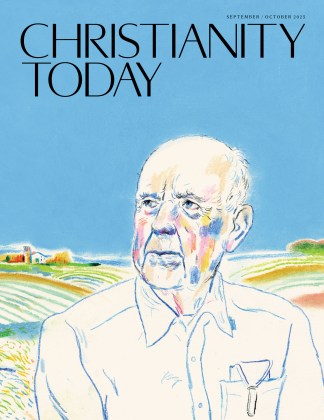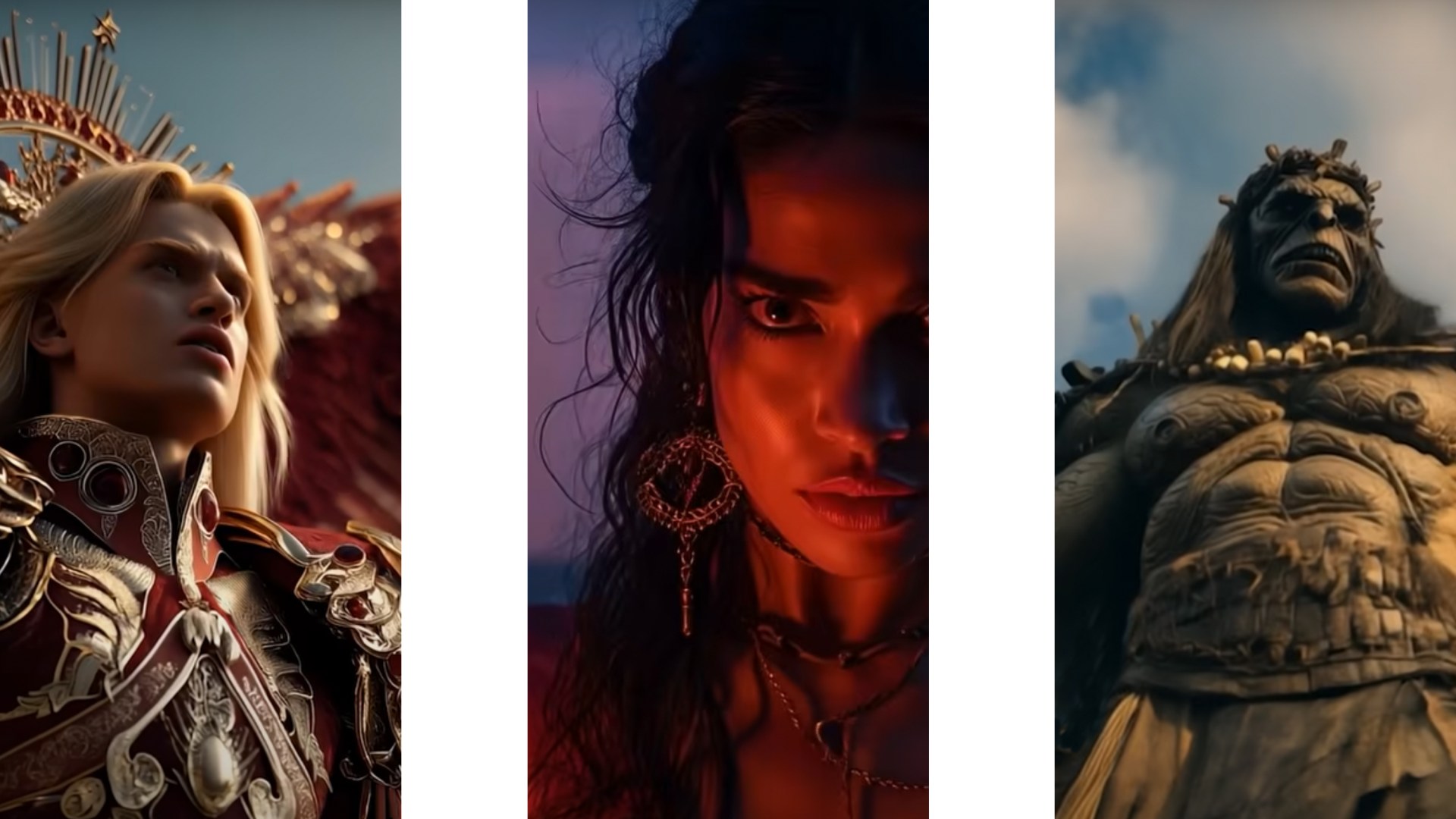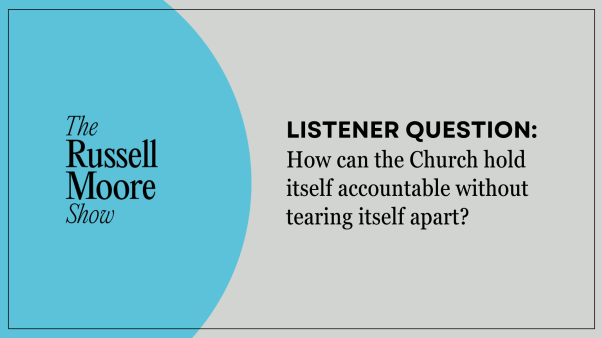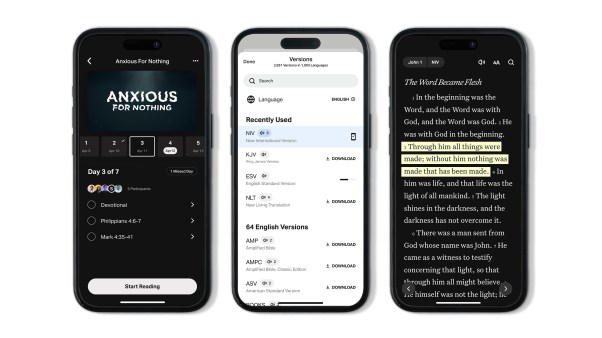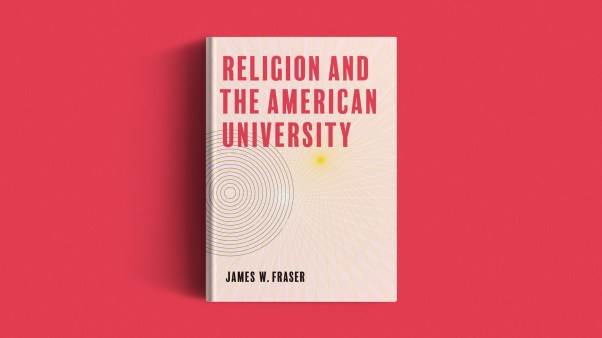When generative artificial intelligence programs like ChatGPT first became widely available in late 2022, many people—including me—marveled at their ability to conjure detailed images from just a few lines of text. Sure, the AI tools struggled to create fingers. But they needed mere seconds to work up images that would take many of us painstaking days to make in Photoshop.
Since then, the capacity of large language models (LLMs) to create imagery, then silent video, then video with sound has rapidly improved. “We can talk!” exclaimed convincing AI-generated characters in a clip that made the rounds online earlier this year.
With this kind of technology on offer, it was inevitable that people would apply it to the Bible—and so they have. AI videos of biblical stories are proliferating, as 404 Media reported in June. Prominent among them is The AI Bible, which has over a million subscribers on YouTube and TikTok combined, and 1.2 million on Instagram.
The AI Bible is a project of Pray.com, a popular app with offerings including bedtime stories, meditations, a reading of the Bible by actor James Earl Jones, Prayer Therapy with TV personality Dr. Phil, and Sleep Psalms with pastor T. D. Jakes. I spoke with Max Bard, vice president of content at Pray.com. This interview has been edited and condensed.
Let’s start with a general introduction for readers who may not be familiar with this project. What is The AI Bible?
In a nutshell, The AI Bible is a series of channels on Instagram, TikTok, YouTube. It’s a project that we’ve created to glorify God using AI, mainly image and video generators. We’re using AI to bring these Bible stories to life like no one’s ever seen before—in these cool, cinematic-looking, and engaging videos with vivid storytelling. That’s what you’ll see on the Instagram and TikTok and YouTube channels.
Since this technology is still so novel, I’d like to take a minute to talk about process. What model do you use to create these videos? And how does the prompting work? Do you simply feed it a passage of Scripture and ask for a movie, or do you give guidance on the story and character design? Or maybe you write a whole script?
It’s a pretty extensive process. When Pray.com started making subscription content back in 2019, it was all audio content. So we had about 5,000 audio stories that we had already produced, and we took those stories and layered video onto that. So a lot of The AI Bible videos on YouTube—the longer form, 10-minute type—were derived from our audio content that we had already produced. It was a way for us to be able to quickly make some videos right off the bat.
All the newer stuff that we make currently has a long process that involves platforms like ChatGPT and Claude, which helps us with outlining what the stories will be. We’ll decide, Okay, we’re going to do the story of Adam and Eve. And then from there it’s like, Okay, how do you structure that into a video?
We have scriptwriters on our team, and one of them is a pastor, so he’ll write the whole script first. That’s the first process. The second process is taking that script and storyboarding it with visuals. That’s text to image, and for that we use the AI programs Midjourney and ChatGPT.
We’ll storyboard out that whole script, and that will help us create the animation next. So if we have a storyboard of, say, 60 scenes or 60 cuts, then we know exactly what the ending frame of each scene is going to look like compared to the beginning frame. That will help us with things like the coloring of the story and making sure we have the characters consistent throughout the story.
Once we make that storyboard in Midjourney and ChatGPT, then we’ll start using the AI video generators to turn those images into animations. You put the image into the video generator, and you tell the video generator what you want it to do. For example, with camera movement: pushing in, pushing out, wide-angle aerial shots, and that type of stuff. You can also tell the video generator what you want the characters to do: walking forward, their facial expressions, all that type of stuff.
I’m curious about the aesthetics of the videos. You mentioned that they’re cinematic, and I definitely see that. But the look is also very reminiscent of video games, especially in the design of the supernatural elements—like Goliath in the full Bible trailer, or the beasts of Revelation, or the Nephilim in one of your most popular videos. Was that a deliberate choice? And if yes, was there a particular purpose or audience you had in mind?
Yeah, it almost looks like Final Fantasy, the video game. We’ve got a lot of people saying that. When we first started pushing into these AI videos, that was the look that Midjourney and other image generators were creating with us.
We did a bunch of tests, and if you look deep in our Instagram or TikTok accounts, you could see different styles and books that we tried. And we took a data-informed approach and just said, Okay, these videos are getting more shares, more reposts, more comments. Let’s stick with this style and run with it. And that’s the style that you’re seeing right now.
We’re always testing different looks, so that’s why one day you may see a totally random style on our accounts. That’s us testing to see if this is going to resonate with people. We like to test a lot, but we think this current look is working really well and people are enjoying it, engaging with the stories, and wanting to learn more.
How do you decide which passages you’re going to pick to make into videos? I was looking over the YouTube channel and saw a lot of the more exciting parts of the Bible: Creation, Revelation, stories with a lot of action and violence and supernatural elements. But, of course, a lot of the Bible isn’t that exciting. It’s letters, sermons, guidance on how to live. Are we ever going to get an AI Bible video of Jesus preaching the Sermon on the Mount?
Yes, we will. And that’s coming pretty soon. We have some series that will be coming out maybe in the next three to four months that will follow Jesus’ life, Paul’s life, Abraham’s life. Those will be something where it’s likely a weekly drop.
Right now, we have a couple of series that we’ve made in the Pray.com app on David’s life, Jesus’ life, and Joseph’s life. For the AI Bible channel, we’ve already produced a series on Ruth, and we’re going to do a lot more of those where we follow a person from the Bible in a four- or five-episode series.
One video that caught my eye was about Job: “When SATAN Almost Won… The Full Story of Job’s Faith.” It’s 10 minutes long and very vivid, but I was struck by the fact that more than half of those 10 minutes are from Job 1, and then most of the book—about 40 chapters of Job and his friends wrestling through questions about why God permits evil and suffering for people who love him—gets taken down to a single spoken verse.
I’m thinking about people who are less scripturally knowledgeable, coming to a video like this. It’s presented as the “full story” of Job, but it doesn’t include any of the complicated rebuke of Job from God at the end and instead has some stuff about hope. As you’re moving into longer video formats, will they include more of the theology and discourse passages?
Yeah, definitely. Right now, we have a podcast called Bible in a Year. And in that series, there’s three stories of Job that I think are about 60 to 90 minutes. So when you take all those, it’s about 90 minutes of Job’s story that we created. And so for this AI Bible video, we had to chuck it down into 10 minutes. So how were we going to figure that out? And that’s what ended up being the 10-minute piece that you saw.
That’s how we’re testing out these stories on the AI Bible channel—to see what are the stories that resonate most with this audience right now. That’s why all the videos you see are 10 minutes. We’re able to make a video like that in a couple of weeks. The subscribers don’t have to wait a month or two for us to put out a 60-minute video or something that would take us quite a while.
So we’re using the 10-minute format to see which of the stories people most want to hear about—and you’ll see that in the comment section too. They’ll tell us like, Hey, I wish you did this story or that story, and then we’ll say, Okay, can we create this as a 10-minute version, see how it does?
And if it does well, let’s break this out into a five- or six-part series, which is something that we would do with Job and really get in-depth. The one that you’re talking about, there’s very little dialogue. It was a lot of just visuals, music, that type of stuff. When we get into the series, that’s when we start putting the dialogue from the Bible in there and really getting in-depth with these stories.
So what you’re seeing with these little 10-minute vignettes are the quickest way that we can get something out there to the users to see if something like this would work.
A video like that—which loses, frankly, the great bulk of Job’s difficult theological content and message—makes me wonder about your process for content review. What you’re putting out might be effective for testing audience interest, but who is making sure it’s theologically sound and historically accurate and biblically faithful? What is the process there?
We have a bunch of different layers of—call it checks and balances. One of them is we have a few pastors and theologians who look over the scripts, making sure that, like you said, it’s biblically accurate.
Before we even get into the image generation and video generation, that process happens—and the majority of the stories are written by pastors and ministers. That’s a great part of it, because they’re teaching these stories every day. We want to make sure that we’re getting them right and making them in a way that people can learn from them.
Let’s turn more toward purpose. Do you see The AI Bible project as discipleship or education or entertainment or what?
Yeah, we call it edutainment—education and entertainment. The value is the way that these stories are styled. They have a specific look to them, right? You watch these stories, and you’re like, Oh, this is AI. This is that AI look. That’s the entertainment part that I think people are really fascinated about.
And that fantasy look that you mentioned we see as bringing in a lot of people, some who aren’t even Christian and are really interested in these stories. Like, Oh, I’ve never seen this before. I didn’t even know these things, like that the Nephilim were in the Bible. This is interesting.
We’re getting all these subscribers, people we never would’ve normally reached from the Pray.com app. It’s reaching a younger audience than traditionally we had before, which is great. And I think it’s really opening the Bible up to a lot more people. You don’t have to know the Bible and the stories to enjoy these videos. You can check them out—maybe because you’re fascinated by the way it looks—and see something new, and then it gets you interested in what else happened in the Bible.
That’s what we’re seeing. A lot of people watch these videos and end up downloading our app. They tell us, Hey, I found you guys from a couple of these AI Bible videos. They didn’t even know that we were producing all of this audio content for Pray.com, and they’re finding us because of these video stories.
It sounds like you guys are very data-informed about the move from the videos to the app. Do you have data that would suggest that watching these videos is leading people to more offline involvement in the faith—reading their Bibles more deeply or more often, or maybe committing to life and worship with a local congregation?
The way we find that out is through qualitative feedback like reviews. We partner with pastors on a lot of podcasts, and we’ve had users who listen to the podcast, say, of Jack Graham’s Bible in a Year podcast. He’s a pastor in Dallas, Texas, and we’ve had people that say, Hey, I’ve been listening to your podcast for the past six months, and I just started going to your church.
We’re like, Wow, we’re seeing people taking action in person just by listening to some of these podcasts and going to their churches, which is awesome. We’re seeing a lot of that. We don’t see it in the app through data, because it doesn’t tell us location, but when people say that in reviews, it’s really powerful. This is proving that it’s working.
Just to make sure I understood you about the podcast partnerships and those reviews, is that through the Pray.com app and the audio content there? Or is that about the AI Bible videos in particular?
With the Pray.com app. Not necessarily the AI videos.
Some people don’t even know that The AI Bible is associated with Pray.com. We’re still working on the branding on that. It’s mainly with the Pray.com app—in the iOS App Store reviews or Google Play store reviews—that you’ll see people mentioning that explicitly.
Gotcha. Now, I can imagine someone making the case that The AI Bible is kind of like stained glass windows—and I’ll be interested to know if you’ve used this analogy.
When most Christians were illiterate in the premodern era, one reason they’d build cathedrals with lots of stained glass and mosaics was that people who couldn’t read and couldn’t understand most of the services in Latin could still learn the Bible stories by looking at those images. We’re in an increasingly postliterate era, and I can imagine someone saying, Well, we need to be making the Bible into video so that people who just will not read have a way to learn these stories.
But then I thought, Does the comparison work? Because you can sit in front of a stained glass window or a beautiful painting of the Crucifixion and engage in contemplative prayer. You can study the artwork while you talk to God. But the videos are very high drama. They’re very engrossing. And I see the appeal of that, of course, but it doesn’t seem conducive to contemplative prayer—honestly to any kind of prayer. I’m wondering what you think about that analogy.
Yeah, I see it as it’s another way of storytelling. It’s interesting that you brought that up—that there are a lot of people out there who either don’t or can’t read or maybe physically can’t read because they have a hard time seeing.
Many people who use our app are in that bucket, and we know that because they’ve left the reviews saying they have a hard time reading but enjoy listening to the stories. There are also people that enjoy learning through visual storytelling. That’s what The AI Bible project is all about: learning these stories in a different format that you can literally just watch and be fascinated by all the stories in the Bible that happened.
Some people don’t even know about stuff like the Nephilim, right? To be honest, I hadn’t read the Bible front to back before joining Pray.com, so I didn’t even know a lot of these stories. I’ve learned so much just working at Pray.com. Seeing these stories is exciting, and it makes me more engaged to learn more about the Bible.
It’ll almost be like a History Channel show, where you get these really awesome reenactments and then also commentary from pastors and theologians that helps guide you through these stories. And then you come back to these epic stories, and then you come back to the pastor explaining why it’s important, how you can apply it to your life. That’s where we’re going with this whole project.
Lastly, you’ve mentioned your work with data, and this is something we deal with in journalism too: questions of how to balance your mission with wanting people to look at the work—wanting to get people’s attention. That’s a real tension in lines of work that involve content creation.
I couldn’t help but notice that many of the characters in AI Bible videos—and this is true of the positive male figures, but even more so of the women—they’re very sexy. And some, like Jezebel in the Bible villains video, are showing a lot of skin.
Prior to seeing that video, in a conversation with a theologian, we said, Well, maybe you would show a video like this in a youth group setting and then use it to spark discussion. But I can’t imagine showing Jezebel and what she’s wearing there to a bunch of middle school boys. So I’m curious about the role you all see for that kind of sex appeal in teaching people about the Bible.
There are a lot of different approaches to it, right? We stay as true as possible to the Bible as we can. And so when we’re looking up images of—there’s not a ton of images of Jezebel on Google, but she’s typically wearing this dress, and we just portrayed this same sort of look that she has on a few images in Google and then used AI to bring it more to life.
I can see your point where it may look a little more sexy than I guess you had imagined, but I think in the Bible she was this kind of villain—not the person you would look up to from the Bible. So we took this route. Obviously, we didn’t want to make her way too sexy, right?
But yeah, there were a few people who had your reaction where it’s like, This could be a little too much for middle schoolers, like you brought up. That’s part of our testing process right now: How far do you go on these styles, and where are the pullbacks on it?
